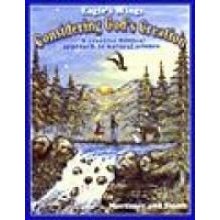Considering God's Creation is a multi-grade science curriculum is for children in grades two through seven. Creation serves as the backdrop for science studies that can be easily adapted for multi-level teaching in the home school setting. This one-year program is contained in a teacher’s manual and a student book. The publisher says it can also be used as a supplement to other curriculum if desired, but I doubt many use it that way.
The teacher’s manual contains the lessons, written in an easy-to-use format. Each lesson first describes advance preparation required. Next are vocabulary words listed with definitions and origins. Following is the “introduction”—actually the main idea of the lesson—which can be read to students directly from the book. The words from an original song/poem about the lesson are included. The actual song is on the accompanying professionally-recorded audio CD that comes in an attached envelope in the back of teacher’s manual. (Cassettes are also available.)
Because the authors believe in hands-on activities for effective learning, at least one such activity is described in each lesson. Many of the activities utilize student activity pages from the 270-page student book.
While a Christian view of science is presented throughout each lesson, a special section called Bible Reading directs students to Scripture for verses related to the subject under study. The creationist viewpoint, including belief in a young earth, is a dominant theme. A fun extra, called “Evolution Stumpers,” provides tidbits of scientific information with which to challenge the theory of evolution.
A review section includes questions to pose to your children about each lesson. Since the curriculum is designed for a wide age span, the final section, “Digging Deeper,” offers suggestions for additional study, activities, investigations, reading, reports, etc., which can be used as is appropriate with each student.
The student workbook consists of work/activity pages. You are free to make copies for immediate family and classroom use only, although you might prefer to order a separate workbook for each student. These sheets are often the foundation for investigations or experiments, or they are used for cut-and-paste activities, all of which are essential parts of the curriculum.
Students compile their own notebooks as they work through these activities and lessons. A few extra items will be needed for activities—crayons, scissors, and glue for most lessons, plus items like flashlights, shoe boxes, rocks, and library/resource books on particular topics.
Topics covered include creation, the universe, the earth, rocks and minerals, weather, plant kingdom, ecology, insects, spiders, fish, reptiles, birds, mammals, amphibians, animal structures, food chains, animal reproduction, instinct, man, and scientists. None of these topics is covered thoroughly, since that would be impossible within a one-year curriculum. If you examine the list of topics, you can see that life science receives the most attention with earth science filling the remainder.
We definitely need to make decisions about what to require from each child, since some material will be too challenging for young students and some not challenging enough for older students. It also requires significant preparation and presentation time. However, this curriculum is one of the best for homeschool families that want a Christian science curriculum for teaching a broad span of grade levels together.









